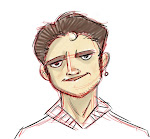 SLOW IN and SLOW OUT:
SLOW IN and SLOW OUT:This rule are very important cause cause the slow in and the slow out gives at the animation fluidity and naturalness.
Normally we can operate on two ways to makes slow effect;
With the spacing and with the timing:
SPACINGIf we adjust more drawings at the begin of an action and more drawings at the end of an action do we have slow in and slow out;
As we can see on the pic above the chart are stuctured in this way..
When an action begin and an action finish?An action involved in an animation are gived by the arc used for the animation.
When begin the arc there are the begin of an action, when finish this arc there will be the end of the action.
TIMINGIf we operate with the timing we gived 2 on the x-sheet at the begin of the action, 1 in the middle and 2 at the end of the action.
That's are the way used by the old Disney's animators.
THE GOOD WAYAnyway the better way are to combined the 2 methods.
The spacing where adjust more drawing, and the timing.
That's will give you a better fluidity, and overall a good timing without compromised the action














